MIKROGEN recomLine EBV IgG [Avidity] recomLine EBV IgM [IgA ...
MIKROGEN recomLine EBV IgG [Avidity] recomLine EBV IgM [IgA ...
MIKROGEN recomLine EBV IgG [Avidity] recomLine EBV IgM [IgA ...
You also want an ePaper? Increase the reach of your titles
YUMPU automatically turns print PDFs into web optimized ePapers that Google loves.
E<br />
Line-Assay<br />
Epstein-Barr Virus<br />
<strong>recomLine</strong> <strong>EBV</strong> <strong>IgG</strong> [<strong>Avidity</strong>]<br />
<strong>recomLine</strong> <strong>EBV</strong> <strong>IgM</strong> [<strong>IgA</strong>]<br />
Strip-Immunoassay with antigens produced by recombinant techniques for the detection<br />
of <strong>IgG</strong> and <strong>IgM</strong> antibodies against the Epstein-Barr virus (<strong>EBV</strong>).<br />
The Epstein-Barr virus, an ubiquitously occurring herpes virus, can cause the symptoms<br />
of infectious mononucleosis (Pfeiffer´s disease) on primary infection. Moreover, as a<br />
result of the lifelong persistence of this pathogen, reactivations can occur, especially<br />
in immuno-incompetent persons.<br />
Due to the diversity of symptoms caused by primary infection or reactivation and their<br />
correspondence with the symptoms of other diseases, one of the main tasks in routine<br />
diagnosis is the serological detection of a primary infection, past infection or possible<br />
reactivation. For this purpose, a series of individual determinations (EIA and IFT) are<br />
generally carried out for the particular class of antigen and type of antibody.<br />
The <strong>recomLine</strong> <strong>EBV</strong>, with the antigens sprayed onto the nitrocellulose, is designed as<br />
screening immunoassay. The line-assay technique allows the detection and identification<br />
of <strong>IgG</strong> and <strong>IgM</strong> antibodies directed against the different <strong>EBV</strong> antigen classes in a<br />
single approach. The application of highly specific and characteristic <strong>EBV</strong> proteins is<br />
made possible by the use of antigens produced by genetic engineering.<br />
„The combination of p18 and EBNA-1 (in <strong>IgG</strong> detection) represents a so far unrivalled degree of<br />
certainty in the exclusion of primary infections ...“<br />
Prof. Dr. G. Bauer, Freiburg ‘99<br />
<strong>MIKROGEN</strong><br />
molekularbiologische Entwicklungs-GmbH<br />
� Product Advantages<br />
Recombinant antigens, therefore:<br />
➣ High sensitivity and specificity<br />
➣ Easy and clear interpretation due to easy to read bands<br />
➣ No interference with anticellular antibodies<br />
Easy test procedure; automation possible<br />
Safe evaluation due to strip specific controls (cut-off and conjugate control)<br />
Separate detection of <strong>IgG</strong>, <strong>IgM</strong> and <strong>IgA</strong> antibodies possible<br />
Easy and reliable determination of avidity possible<br />
Screening of different anti-<strong>EBV</strong> antibodies in a single approach<br />
CE label: The <strong>recomLine</strong> <strong>EBV</strong> tests meet the high standard of the EC directive 98/79/EC on in vitro diagnostic<br />
medical devices<br />
More than 95 % of the past <strong>EBV</strong> infections are correctly identified with the <strong>recomLine</strong> <strong>EBV</strong> <strong>IgG</strong> strip only<br />
� Recombinant <strong>EBV</strong> Antigens used in the Test<br />
<strong>EBV</strong> Antigen<br />
Groups<br />
Abbreviation Recombinant Antigen<br />
Size<br />
of<br />
rec.<br />
Antigens<br />
Nuclear Antigen<br />
EBNA-1 p 72<br />
45<br />
kDal<br />
Virus capsid/<br />
structural<br />
antigens<br />
VCA<br />
" Early<br />
antigens"<br />
EA<br />
p 23<br />
p18<br />
p 54<br />
p 138<br />
React. contr.<br />
Conjugate contr.<br />
<strong>IgG</strong><br />
<strong>IgA</strong><br />
<strong>IgM</strong><br />
Cut-off contr.<br />
EBNA-1<br />
p18 (VCA)<br />
p23 (VCA)<br />
p138 (EA)<br />
p54 (EA)<br />
23<br />
kDal<br />
18<br />
kDal<br />
54<br />
kDal<br />
40<br />
kDal
� Testprinciple and Procedure<br />
� Evaluation<br />
E E E<br />
1 st Incubation: A test strip loaded with <strong>EBV</strong> antigens is incubated with diluted<br />
serum or plasma in a dish for 60 min.<br />
wash 3 times<br />
2 nd Incubation: Peroxidase conjugated anti-human antibodies (<strong>IgG</strong>, <strong>IgM</strong> or<br />
<strong>IgA</strong> specific) are added. Incubate for 45 min.<br />
wash 3 times<br />
3 rd Incubation: 5 - 10 minutes after addition of the coloring solution, insoluble<br />
colored bands develop at the sites on the test strips occupied<br />
by antibodies.<br />
In comparison to the ELISA, the <strong>recomLine</strong> <strong>EBV</strong> allows a more sensitive determination of the <strong>EBV</strong> status as a rule. In the following a series of<br />
different dilutions of three <strong>EBV</strong> positive sera were analysed with the <strong>recomLine</strong> <strong>EBV</strong> <strong>IgG</strong> as well as with commercially available <strong>EBV</strong> ELISAs. The<br />
results show, that with the <strong>recomLine</strong> <strong>EBV</strong> the detection of anti-<strong>EBV</strong> antibodies is usually one to two titration steps more sensitive when compared<br />
with the ELISAs. As a consequence, sera with very low anti-<strong>EBV</strong> antibody titres, that are determined false-negative with the ELISA, will be<br />
determined true-positive with the <strong>recomLine</strong> <strong>EBV</strong>.<br />
Cut-off contr.<br />
Ig class contr.<br />
EBNA-1<br />
p18<br />
p23<br />
<strong>recomLine</strong> <strong>EBV</strong> <strong>IgG</strong><br />
Dilution EBNA-1 p18 (VCA) p23 (VCA) p138 (EA) p54 (EA) EBNA VCA-G<br />
The grey bars depict the serum dilution where the determination of the <strong>EBV</strong> status is still possible.<br />
The borderline ELISA results are marked with open bars.<br />
� Storage and Shelf life At 4 °C, 18 months from the time of production<br />
� Commercial Product Article No. 4572 <strong>recomLine</strong> <strong>EBV</strong> <strong>IgG</strong> [<strong>Avidity</strong>]*<br />
Reagents for 50 determinations<br />
* [ ] optional available<br />
as additional reagent<br />
p138<br />
p54<br />
Article No. 4573 <strong>recomLine</strong> <strong>EBV</strong> <strong>IgM</strong> [<strong>IgA</strong>]*<br />
Reagents for 50 determinations<br />
Article No. 10076 Line - anti-human <strong>IgA</strong> conjugate, 12 ml<br />
Article No. 11010 Blot, Line - avidity reagent<br />
Reagent for 25 avidity determinations<br />
<strong>MIKROGEN</strong> GmbH<br />
Floriansbogen 2-4 · D-82061 Neuried · Germany · Tel.: +49 (0)89 54801-0 · Fax: +49 (0)89 54801-100<br />
Internet: www.mikrogen.de · eMail: mikrogen@mikrogen.de<br />
ELISA cut-off index<br />
1 : 100 +++ ++ ++ - - 8,36 11,60<br />
1 : 200 +++ ++ ++ - - 8,36 9,54<br />
1 : 400 +++ ++ ++ - - 6,23 5,76<br />
1 : 800 ++ + + - - 3,52 3,24<br />
1 : 1600 ++ + + - - 2,00 1,73<br />
1 : 3200 + + +/- - - 1,23 0,89<br />
1 : 6400 +/- - - - - 0,65 0,43<br />
1 : 12800 +/- - - - - 0,32 0,26<br />
1 : 100 +++ ++ ++ - +/- 6,07 12,07<br />
1 : 200 ++ ++ ++ - - 3,84 12,07<br />
1 : 400 ++ ++ ++ - - 2,26 6,69<br />
1 : 800 ++ + + - - 1,17 3,84<br />
1 : 1600 + + + - - 0,65 1,97<br />
1 : 3200 +/- + +/- - - 0,39 1,03<br />
1 : 6400 +/- - - - - 0,22 0,55<br />
1 : 12800 - - - - - 0,15 0,29<br />
1 : 100 +++ +++ +++ - - 8,83 12,07<br />
1 : 200 +++ +++ +++ - - 7,15 10,62<br />
1 : 400 ++ +++ +++ - - 4,33 7,44<br />
1 : 800 ++ +++ +++ - - 2,34 4,52<br />
1 : 1600 + ++ ++ - - 1,42 2,64<br />
1 : 3200 + ++ + - - 0,76 1,62<br />
1 : 6400 +/- + +/- - - 0,41 0,86<br />
1 : 12800 - +/- +/- - - 0,21 0,45<br />
pirlebe006a


![MIKROGEN recomLine EBV IgG [Avidity] recomLine EBV IgM [IgA ...](https://img.yumpu.com/4999659/1/500x640/mikrogen-recomline-ebv-igg-avidity-recomline-ebv-igm-iga-.jpg)

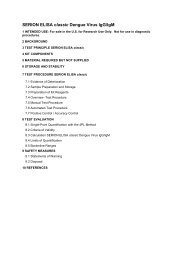
![MIKROGEN recomBlot CMV IgG [Avidity] recomBlot CMV IgM ...](https://img.yumpu.com/47840028/1/185x260/mikrogen-recomblot-cmv-igg-avidity-recomblot-cmv-igm-.jpg?quality=85)
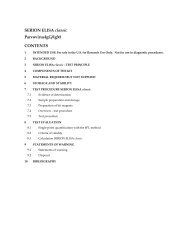
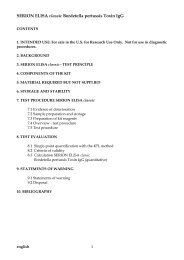
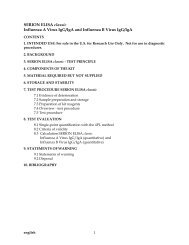

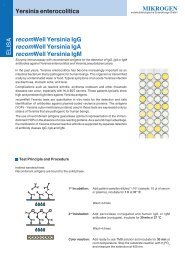
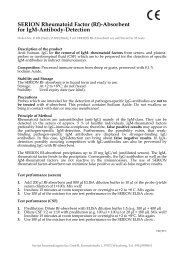

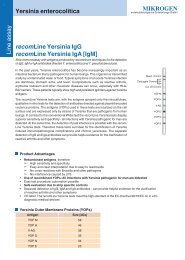
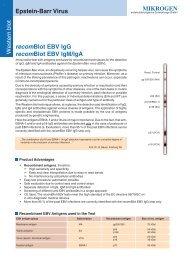
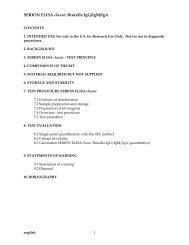

![MIKROGEN recomLine Parvovirus B19 IgG [Avidity] recomLine ...](https://img.yumpu.com/31102785/1/185x260/mikrogen-recomline-parvovirus-b19-igg-avidity-recomline-.jpg?quality=85)